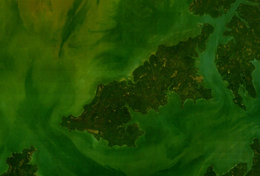Bolama Island
This article needs additional citations for verification. (June 2020) |
Native name: Ilha de Bolama | |
|---|---|
 Aerial image of Bolama | |
| Geography | |
| Location | Atlantic Ocean |
| Coordinates | 11°33′N 15°32′W / 11.550°N 15.533°W |
| Archipelago | Bissagos Islands |
| Area | 65 km2 (25 sq mi) |
| Administration | |
GNB | |
| Demographics | |
| Population | 6024 (2009)2009 census[1] |
| Pop. density | 93/km2 (241/sq mi) |
Bolama is the closest of the Bissagos Islands to the mainland of Guinea-Bissau. The island has a population of 6,024 (2009 census).[1] It shares its name with ist largest settlement, the town Bolama, which is the capital of the island and the Bolama Region.
It is almost surrounded by
History
In 1792, a group of officers of the
The
A fruit processing plant was built on Bolama shortly after independence of Guinea-Bissau, with Dutch foreign aid. This plant produced canned juice and jelly of cashew fruit. However, it could not expand and had to shut down its operations, due to the shortage of fresh water on the island.
Attractions on the island include sandy beaches and the abandoned ruins of the town of Bolama. It is also designated as a biosphere reserve, and the Bissau-Guinean government is aiming for it to be designated the nation's first World Heritage Site. A causeway links the island to the Ilha das Cobras.
Further reading
The history of the English colonisation attempt in 1792 is chronicled in the first six chapters of the 2013 book "The Ship of Death: The Voyage that Changed the Atlantic World" by (professor of history) Billy G. Smith.[6]
References
- ^ a b População por região, sector e localidades por sexo censo 2009 Archived 2020-03-31 at the Wayback Machine, Instituto Nacional de Estatística Guiné-Bissau
- ^ Humphries, Will (4 November 2020). "How Britain's colony without slaves ended in bloodshed". The Times. London.
- ^ Extracts describing the abortive colonization of Bulama island, in the mouth of the Rio Grande river (now Bolama island, Corubala river, Guinea Bissau), in 1792 at Glamorgan Archives
- ISBN 9781452088693.
- ^ "History of Bolama, the first capital of Portuguese Guinea (1879-1941), as reflected in the Guinean National Historical Archives". British Library, Endangered Archives Programme. 2017-09-06. Retrieved 2020-06-30.
- ISBN 9780300194524.
External links
- Abolition Gone Wrong - article about the failed 1792 English settlement of Bolama

